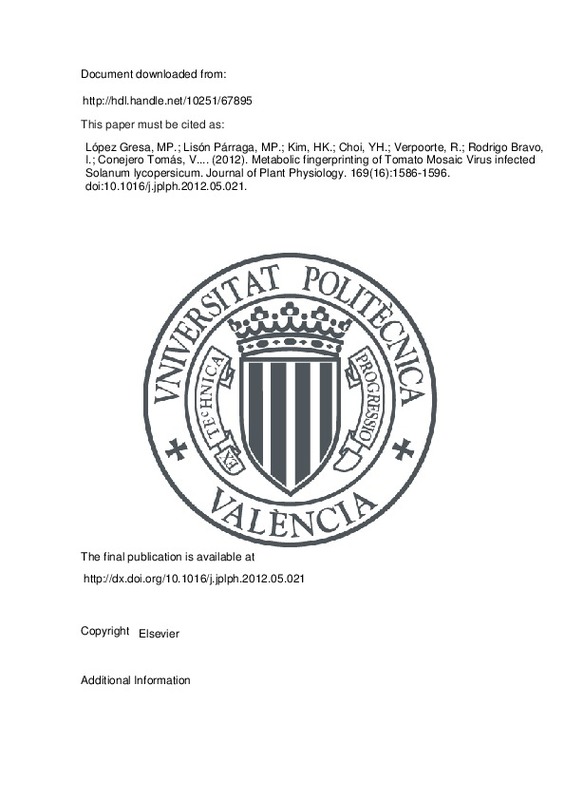JavaScript is disabled for your browser. Some features of this site may not work without it.
Buscar en RiuNet
Listar
Mi cuenta
Estadísticas
Ayuda RiuNet
Admin. UPV
Metabolic fingerprinting of Tomato Mosaic Virus infected Solanum lycopersicum
Mostrar el registro sencillo del ítem
Ficheros en el ítem
| dc.contributor.author | López Gresa, Mª Pilar
|
es_ES |
| dc.contributor.author | Lisón Párraga, María Purificación
|
es_ES |
| dc.contributor.author | Kim, Hye Kyong
|
es_ES |
| dc.contributor.author | Choi, Young Hae
|
es_ES |
| dc.contributor.author | Verpoorte, R
|
es_ES |
| dc.contributor.author | Rodrigo Bravo, Ismael
|
es_ES |
| dc.contributor.author | Conejero Tomás, Vicente
|
es_ES |
| dc.contributor.author | Belles Albert, José Mª
|
es_ES |
| dc.date.accessioned | 2016-07-20T10:36:24Z | |
| dc.date.available | 2016-07-20T10:36:24Z | |
| dc.date.issued | 2012-11-01 | |
| dc.identifier.issn | 0176-1617 | |
| dc.identifier.uri | http://hdl.handle.net/10251/67895 | |
| dc.description.abstract | [EN] 1H nuclear magnetic resonance (NMR)-based metabolomics has been applied to study the compatible interaction between tomato plants and Tomato Mosaic Virus (ToMV). A detailed time course of metabolic fingerprinting of ToMV-inoculated and non-inoculated systemically infected tomato leaves has provided a fundamental understanding of the metabolic state of the plant not only in response to ToMV infection, but also under various physiological conditions. By this analytical platform a total of 32 metabolites including amino/organic acids, sugars, phenylpropanoids, flavonoids and other miscellaneous compounds were detected. Using multivariate data analysis, we have identified a subset of metabolites induced during the plant defence response and metabolites whose accumulation was dependent on the developmental stage, the position of the leaf on the stem, and the harvesting time. Specifically, a general time-dependent decrease in organic acids, amino acids (excluding asparagine), phenylpropanoids and rutin was observed in individual leaves. In addition, metabolite alterations were also found to correlate with the developmental stage of the leaf: high levels of organic acids, some amino acids, phenylpropanoids, and flavonoids were found in lower leaves while elevated amounts of sugars were present in the upper ones. Moreover, a marked variation in the content of some metabolites was also observed to be associated to the asymptomatic ToMV infection both in inoculated and systemically infected leaves. While flavonoids accumulated in virus-inoculated leaves, increased levels of phenylpropanoids were observed in non-inoculated leaves where ToMV actively replicates. Finally, diurnal changes in the metabolite content were also observed: an increase of amino acids and organic acids (except glutamic acid) were observed in the samples collected in the morning, whereas sugars and secondary metabolite levels increased in the tomato leaves harvested in the evening | es_ES |
| dc.description.sponsorship | The authors are grateful to Cristina Torres Vidal for technical support and Dr. Lynne Yenush for critical reading of the manuscript and exciting intellectual discussions. This work was supported by Grant BFU 2009-11958 from Secretaria de Estado de Investigacion from Spanish Ministry of Science and Innovation. M.P.L.G held a postdoctoral fellowship JAEDoc 08 00402 from the Consejo Superior de Investigaciones Cientificas (Spain) and was recipient of a postdoctoral fellowship (BEST/2010/111) from Generalitat Valencia (Spain). | en_EN |
| dc.language | Inglés | es_ES |
| dc.publisher | Elsevier | es_ES |
| dc.relation.ispartof | Journal of Plant Physiology | es_ES |
| dc.rights | Reserva de todos los derechos | es_ES |
| dc.subject | Solanum lycopersicum | es_ES |
| dc.subject | Tomato Mosaic Virus (ToMV) | es_ES |
| dc.subject | Plant pathogen interaction | es_ES |
| dc.subject | Systemic acquired resistance (SAR) | es_ES |
| dc.subject | NMR-based metabolomics | es_ES |
| dc.subject.classification | BIOQUIMICA Y BIOLOGIA MOLECULAR | es_ES |
| dc.title | Metabolic fingerprinting of Tomato Mosaic Virus infected Solanum lycopersicum | es_ES |
| dc.type | Artículo | es_ES |
| dc.identifier.doi | 10.1016/j.jplph.2012.05.021 | |
| dc.relation.projectID | info:eu-repo/grantAgreement/MICINN//BFU2009-11958/ES/Señalizacion Y Respuesta Defensiva De Las Plantas Frente A Patogenos/ | es_ES |
| dc.relation.projectID | info:eu-repo/grantAgreement/CSIC//JAEDoc 08 00402/ | es_ES |
| dc.relation.projectID | info:eu-repo/grantAgreement/GVA//BEST%2F2010%2F111/ | es_ES |
| dc.rights.accessRights | Abierto | es_ES |
| dc.contributor.affiliation | Universitat Politècnica de València. Departamento de Biotecnología - Departament de Biotecnologia | es_ES |
| dc.description.bibliographicCitation | López Gresa, MP.; Lisón Párraga, MP.; Kim, HK.; Choi, YH.; Verpoorte, R.; Rodrigo Bravo, I.; Conejero Tomás, V.... (2012). Metabolic fingerprinting of Tomato Mosaic Virus infected Solanum lycopersicum. Journal of Plant Physiology. 169(16):1586-1596. https://doi.org/10.1016/j.jplph.2012.05.021 | es_ES |
| dc.description.accrualMethod | S | es_ES |
| dc.relation.publisherversion | http://dx.doi.org/10.1016/j.jplph.2012.05.021 | es_ES |
| dc.description.upvformatpinicio | 1586 | es_ES |
| dc.description.upvformatpfin | 1596 | es_ES |
| dc.type.version | info:eu-repo/semantics/publishedVersion | es_ES |
| dc.description.volume | 169 | es_ES |
| dc.description.issue | 16 | es_ES |
| dc.relation.senia | 231123 | es_ES |
| dc.contributor.funder | Ministerio de Ciencia e Innovación | es_ES |
| dc.contributor.funder | Generalitat Valenciana | es_ES |
| dc.contributor.funder | Consejo Superior de Investigaciones Científicas | es_ES |







![[Cerrado]](/themes/UPV/images/candado.png)

